Razer Kiyo Pro review: One of the best webcams out there - mcevoyalliver
The Razer Kiyo Pro webcam is impressive. Piece the specs—1080p, 60fps—Don't look like anything on composition, the combination of software and hardware equal a device that I have no problem recommending—scorn its high cost. At $200 you mightiness wonder how much better it could be compared to Sir Thomas More budget-friendly and classic options like the Logitech C920, so let Pine Tree State tell you: Under most lot—whether you are hosting a Whizz along academic session or streaming video recording games to the world—the quality surprised me.
 Adam Patrick Murray/IDG
Adam Patrick Murray/IDG Razer Kiyo Pro decorated on 27-inch monitor.
Kiyo Pro hardware and software
The Kiyo Pro ships with a nice, 1.5-meter braided USB 3.0 cablegram. The wire connects to the webcam via USB-C, and to your PC via USB-A. It's thick and long-snouted enough to handle near setups, but Thomas More significantly, it's replaceable just in case you ask something thinner or shorter. Some other incentive in the box: a plastic privacy shield for covering up the camera when it's non being used.
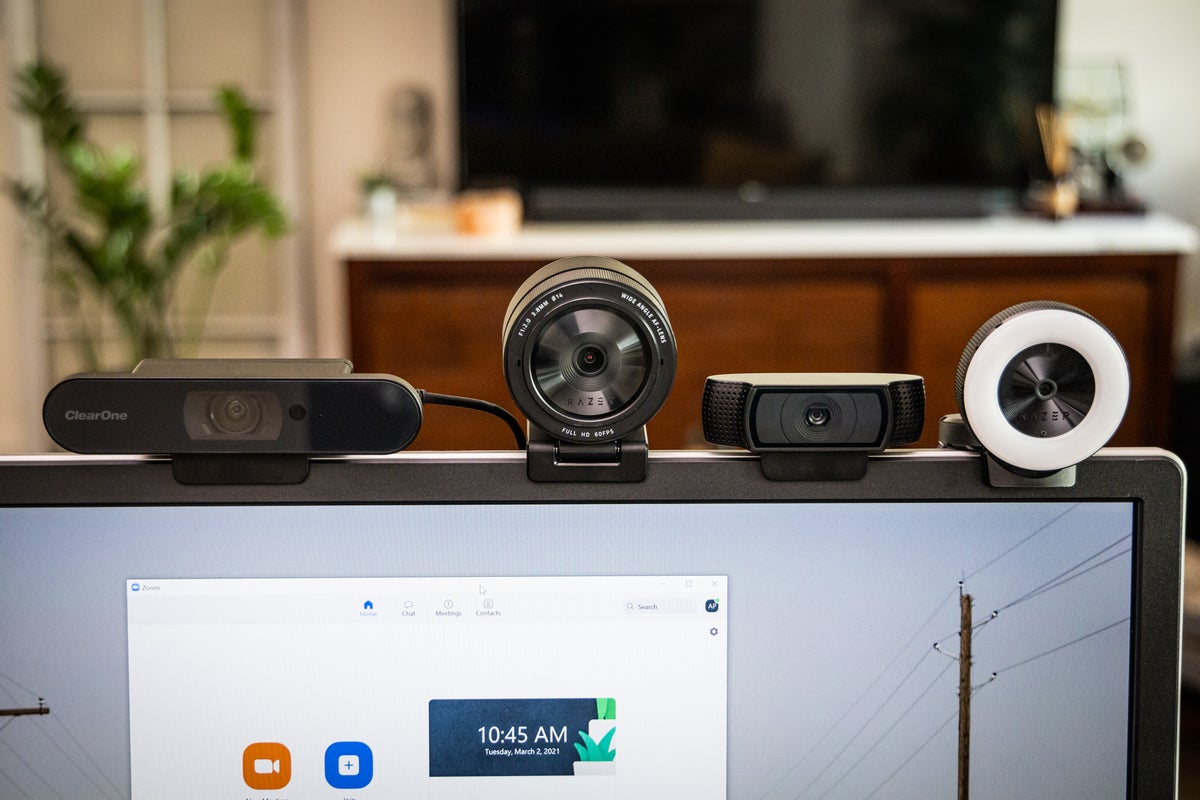 Adam Patrick Murray/IDG
Adam Patrick Murray/IDG Left to right: ClearOne Unite 50 4k AF, Razer Kiyo Favoring, Logitech C920, Razer Kiyo.2.
The design is impressive. The television camera itself is considerably larger than the original Kiyo by every metric, and that makes it feel much nicer and more substantial—a real high-cease piece of gear.
IT too features a wide variety of climbing options, a regale for those who like to customize their frame-up. The included monitor mount has two points of unbent join and features a 1/4"-20 standard tripod setting to screw into most consumer-grade tripods. Don't want to use the included mount? The camera itself is screwed to the mount via that same 1/4"-20 port, making the Kiyo Pro one of the most variable webcams I've seen.
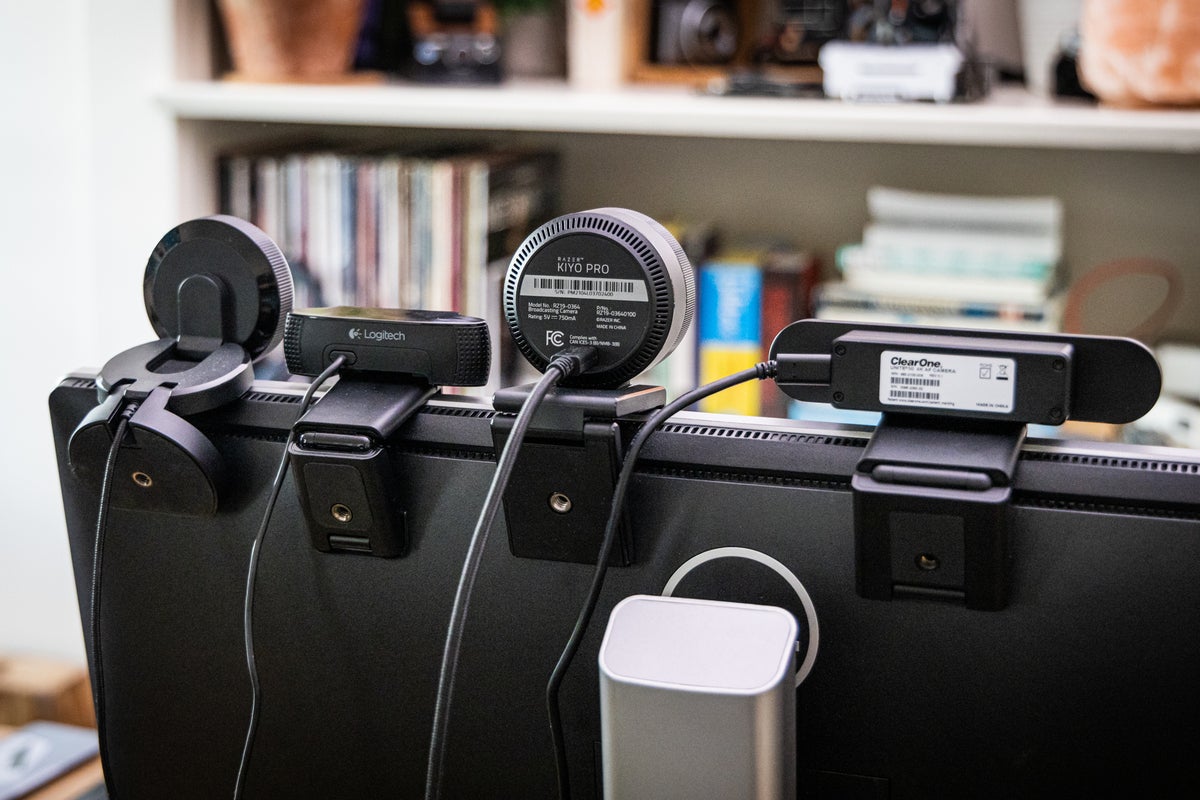 Adam Patrick George Gilbert Aime Murphy/IDG
Adam Patrick George Gilbert Aime Murphy/IDG Gift up concealment in order to bring you this review!
The Kiyo Pro connects to the PC via the standard UVC protocol, meaningful nigh any program will get easy access to the camera. My two of import applications for examination were Zoom and OBS, some of which had nobelium trouble bringing the camera online. While each program has a different toolset for adjusting the TV capabilities of the Kiyo Pro, the easiest way to configure it is via Razer's Synapse software. Interior Synapse you have access to all the tuning options your heart desires, also as some quick presets.
Unfortunately there seem to be a couple of configuration options thataccept to atomic number 4 set inside Synapse: HDR and field (FOV). Out of the package, my Kiyo Pro was set to SDR, and the FOV was put up to its widest angle. SDR vs HDR depends connected your kindling setup, which I'll cut through later, but at its widest FOV (103 degrees) there is considerable fisheye distortion to the image. While I'm glad the choice is at that place just in case I need to fit more the great unwashe in the frame, I primarily use the camera alone, and it looks its best when set to the narrowest option (80 degrees).
The Kiyo Pro can display up to a 1080p sign at 60 fps with SDR, operating theater 30 fps with HDR.
 Adam Patrick Murray/IDG
Adam Patrick Murray/IDG Razer Synapse configuration screen for the Kiyo Pro.
Natural light carrying out
For our webcam tests, we compared the Razer Kiyo Pro against these competitive models: Razer KiyoRemove not-product link, the cheaper (and older) sibling; Logitech C920, the immensely popular and widely used webcam; and the ClearOne Unite 50 4K AFRemove non-product link, a professional-gradation webcam aimed at those larger workspaces. We've ordered them in the included YouTube videos clockwise height left to bottom the right way: start the Razer Kiyo, then the Razer Kiyo Pro, Logitech C920, and the ClearOne Connect 50 4K AF.
Teleconferencing has become an ordinary bodily process, and most people use the natural light they have available to them. The camera victimised is important—it's literally the windowpane through which the citizenry happening the other cease see you. You want to be seen clearly, be properly exposed, and be framed at a proper angle—all things at which the Kiyo Pro excels.
Dextrorotary top left to bottom right: Razer Kiyo, Razer Kiyo Pro, Logitech C920, ClearOne Merge 50 4k AF:
Let's originate with clarity—the sharpness of the image coming out of the Kiyo Pro, and how it compares to opposite webcams. The embedded videos were recorded at 4K, with each camera taking up a 1080p rectangle, running at 30 Federal Protective Service, with default settings. Transmitting video over the internet is always going to require some compression. I chose to base this footage to YouTube, which performs its own compression to the image.
Self-generated kindling is where well-nig webcams excel, so this is one of the best-case scenarios for any webcam. Fine details like my shirt, the hairs in my beard, or the individual record spines show that the two Razer cameras well sharpness out the Logitech C920 in clarity. With these default settings IT appears that Razer adds post-processing sharpening in order to achieve this stand out performance—which is not inevitably a bad matter.
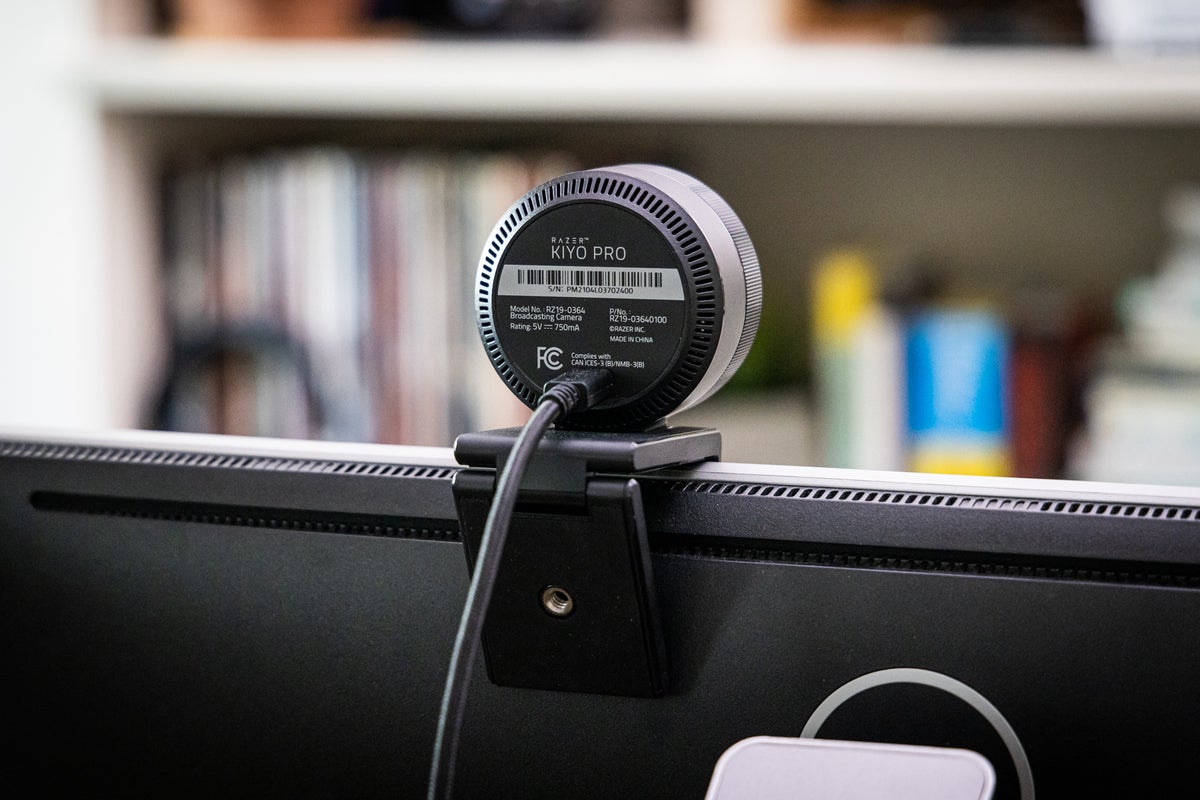 Adam Saint Patrick Sir James Augustus Henry Murra/IDG
Adam Saint Patrick Sir James Augustus Henry Murra/IDG The mounting options on the Kiyo Pro are fantastic.
When it comes to exposure, the underivative Kiyo and the C920 some tend to extinguish opaline spots like white walls. More problematic is when skin is overexposed, in the lead to uncomplimentary white spots connected your face. The Kiyo Pro and the Unite 50 both offer a major exposure, but the ClearOne is too horizontal in its default configuration, and is a tad underexposed for my liking. This stool be corrected in the settings, just it's absorbing to see how these cameras cover themselves correctly out of the box.
I'm the most impressed by the Kiyo In favor of overall, as information technology usually provided a proper exposure and it's not losing so much information in the brightest or the darkest parts of the visualise. I'll note that this isn't even with HDR on. In nigh lighting scenarios like this, information technology's best to lodge with SDR.
Dextral round top left to bottom straight: Razer Kiyo, Razer Kiyo Pro, Logitech C920, ClearOne Merge 50 4k AF:
The next natural-illuminated quiz is a worst-case scenario, where there is sinewy backlighting. This is one of the hardest things for any camera to proportion, as information technology struggles to keep valuable information in some the brightest and darkest parts of the image. Most cameras in auto mode will have to lean toward one of the extremes, which makes faces either besides dark or completely washed-out.
Even with the Kiyo Pro's HDR mode enabled IT give notice't perform miracles, but information technology does by furthest the best job at exposing for the highlights while still maintaining or s light on the issue. In these situations it's best either to add brightness level Beaver State to tweak settings. Patc apiece camera tin comprise tweaked to a certain degree, the Kiyo Pro has the most exposure information to work with. With that aforementioned, no one and only should do any grave television process with a backlit setup.
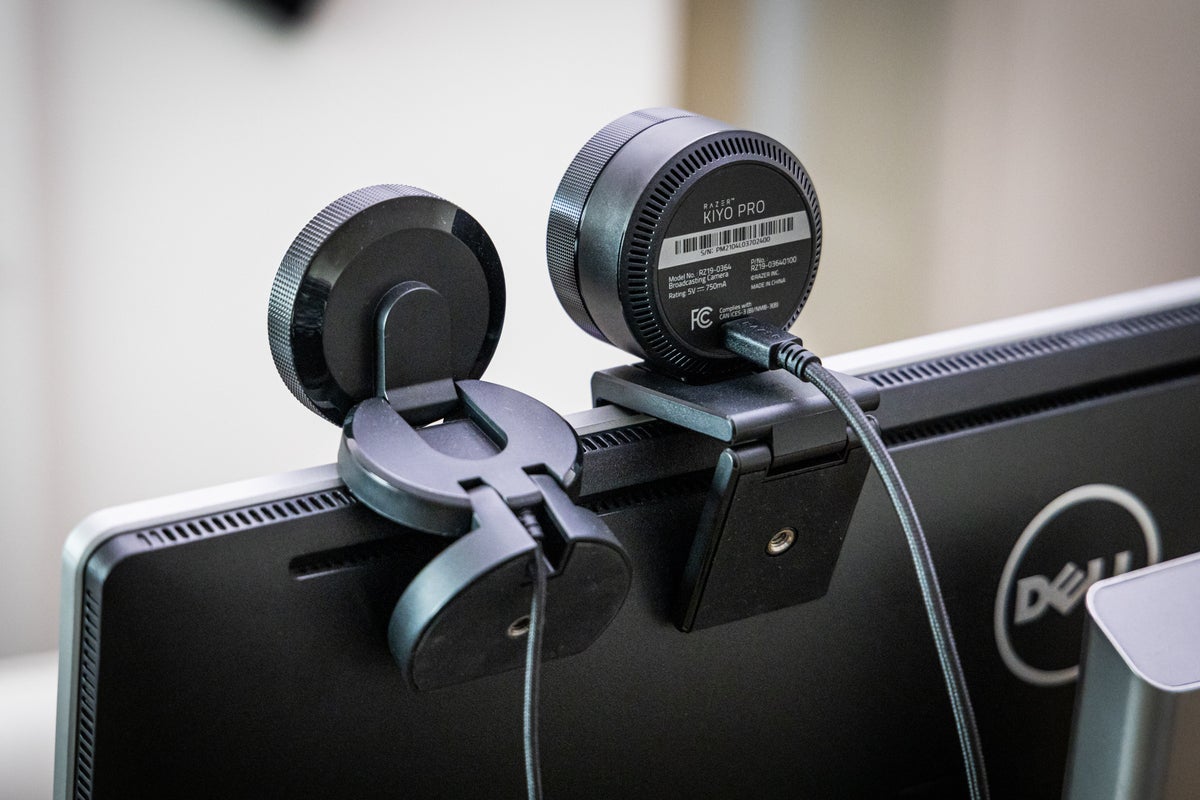 Go Saint Patrick Murray/IDG
Go Saint Patrick Murray/IDG The inclusion of a removable USB-C is an welcome bonus.
One affair that is noticeable in extreme lighting situations is autofocusing performance. Some of the Razer webcams struggle with sharpen hunting—which is when the camera does a visible 'breathing space' ready to find what it should be focusing on. The original Kiyo has always had this problem, even in well-lit scenarios. The Kiyo Pro's carrying into action is amend, though distillery not majuscule.
Staged lighting performance
For those needing a webcam for stream, such Eastern Samoa to Twitch, it's important to see how a camera will perform in staged lighting setups. While my house isn't as complex in footing of lighting Eastern Samoa it would be for vocation streamers, my background as a video director helps me understand how it would perform in most streaming scenarios.
Dextrorotatory top left to bottom letter-perfect: Razer Kiyo, Razer Kiyo Pro, Logitech C920, ClearOne Unite 50 4k AF:
In these types of setups there is usually a main light illuminating the subject, with approximately (often colored) accent lights in the background. As with backlighting, each photographic camera has to decide which parts of the image it should expose for—the more complicated the lighting, the harder information technology becomes.
This scenario tends to trigger focus hunting along the Kiyo Pro. When it happens it's very distracting, and even difficult when you are trying to maintain A level of quality on a stream. I'm not sure which autofocus system Razer employs but it's most likely something that throne't be solved by a darn.
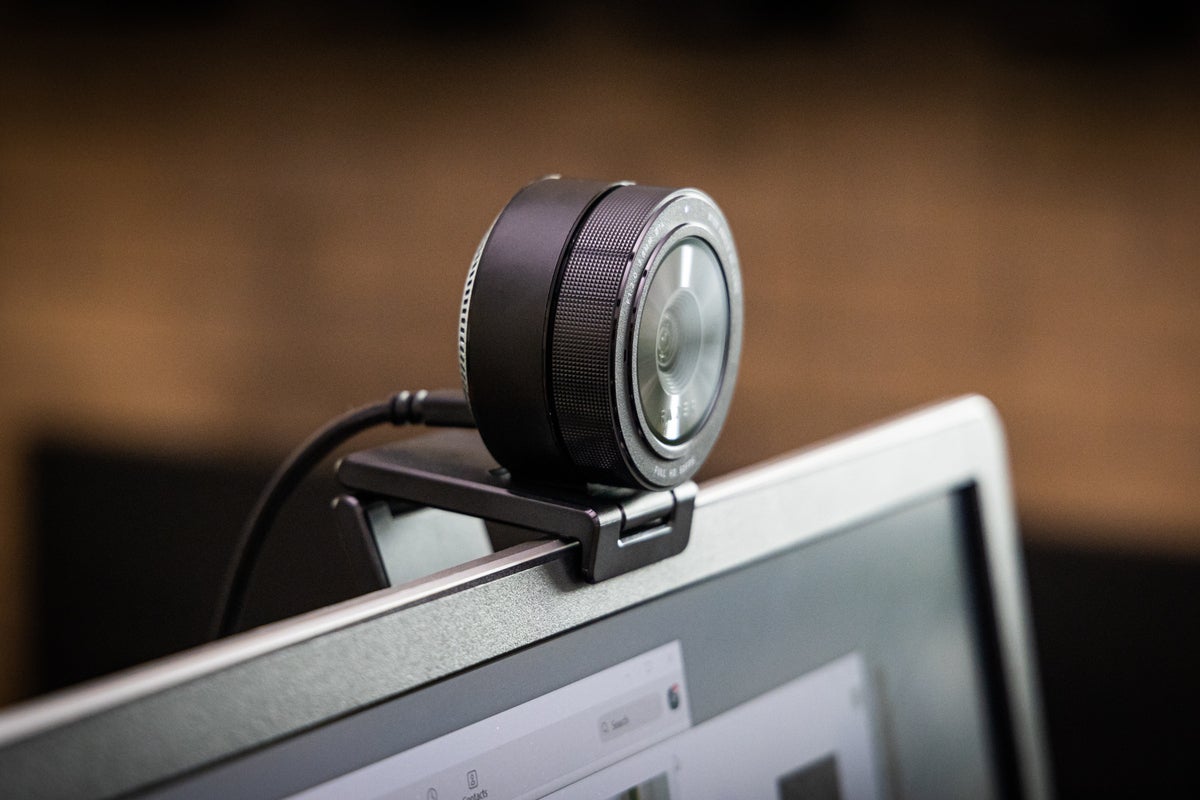 Adam Patrick Murray/IDG
Adam Patrick Murray/IDG The Kiyo Pro might look bulky atop a laptop computer monitor.
If you put up surmount that trouble, the Kiyo Pro performs well otherwise. It is a bit underexposed in the default mode, just leastwise it keeps my face evenly lit. (Many webcams brighten the image overly far, which results in bright spots on the nerve.) When HDR is enabled, however, the Kiyo In favor balances the inflammation comparable a champion. It's a bummer that it seems to be triggerable only within Razer's Synapse software.
Low light performance
What the Kiyo Pro can accomplish in depression light is fantastic. Thanks in part to packing an image sensor that is used in security system systems, the Kiyo Pro delivers an image with stripped-down noise and more accurate colorise procreation.
Dextrorotatory top left to keister right: Razer Kiyo, Razer Kiyo Pro, Logitech C920, ClearOne Unite 50 4k AF:
In auto-mode the original Kiyo exhibits a lot of contrast in its image, which is only compounded when used in low-light conditions. Its built-in ring light (which Acts much like a spotlight in practical terms) helps—and it's a unique feature that most other webcams even so don't sustain—but the public eye-like look it creates, is not for everyone.
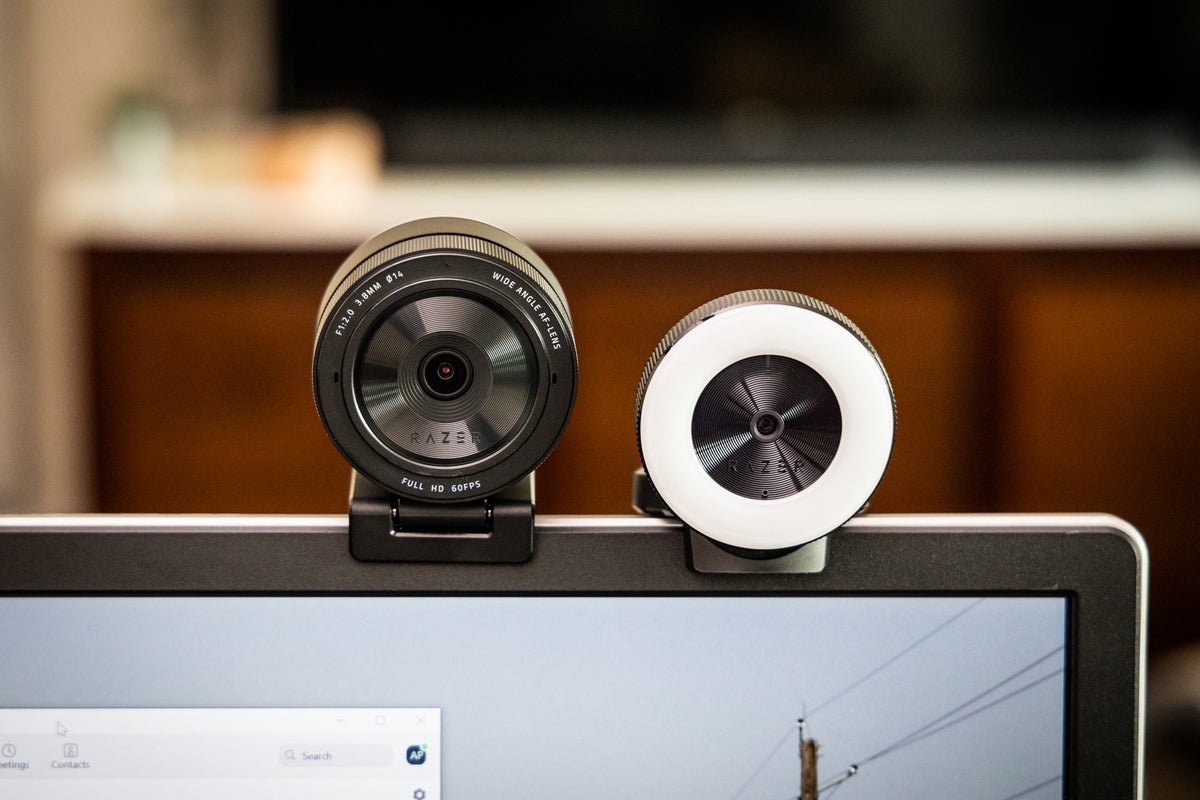 Adam Patrick Murray/IDG
Adam Patrick Murray/IDG The original Kiyo had a handy built in sparkle, just the Kiyo Pro doesn't really need it.
The new Kiyo Pro trades kayoed the stacked-in light for a big, more sensitive sensor. Without getting into the technical particulars of why, just about small-sensor cameras (comparable those found in smartphones) crumple in depressed light, affecting the camera's ability to portray color accurately, for instance. Therein section the Kiyo In favou does impressively well. Not only is it accurate, it also doesn't tend to bring too much contrast the way the original Kiyo did.
In more than virtual terms, the Kiyo In favor of is also able to present a available exposure with marginal noise. It is a fairly noisy image, especially compared to the other cameras we tested, but information technology's mostly relegated to the shadows.
This is another scenario where SDR is typically going to perform better than HDR. HDR is very effective at protecting against blown-out highlights, but in humble lighting you actually desire to habit those highlights to give a better exposure. Like backlit scenarios, I'd like to desire that nonentity is doing serious work in such situations, but if push came to shove I'd favor using the Kiyo Pro.
Conclusion
The Razer Kiyo Pro is one of the best webcams I've ever used. Its high-end computer hardware and easily workable software traits arrive an easy recommendation, as long A you fire swallow the $200 price tag. It strikes a sweet spot for those lacking an easy-to-use camera that looks great without having to take the next step to invest in a DSLR. Asunder from the well-hidden HDR on/off switch and occasional focus-hunting, there is little to dislike. It's a viable alternative for those quest to heavenward their Zoom lame, or to have a needled, sure, and great-performing solution for Twitch moving.
Source: https://www.pcworld.com/article/394156/razer-kiyo-pro-review-one-of-the-best-webcams-out-there.html
Posted by: mcevoyalliver.blogspot.com

0 Response to "Razer Kiyo Pro review: One of the best webcams out there - mcevoyalliver"
Post a Comment